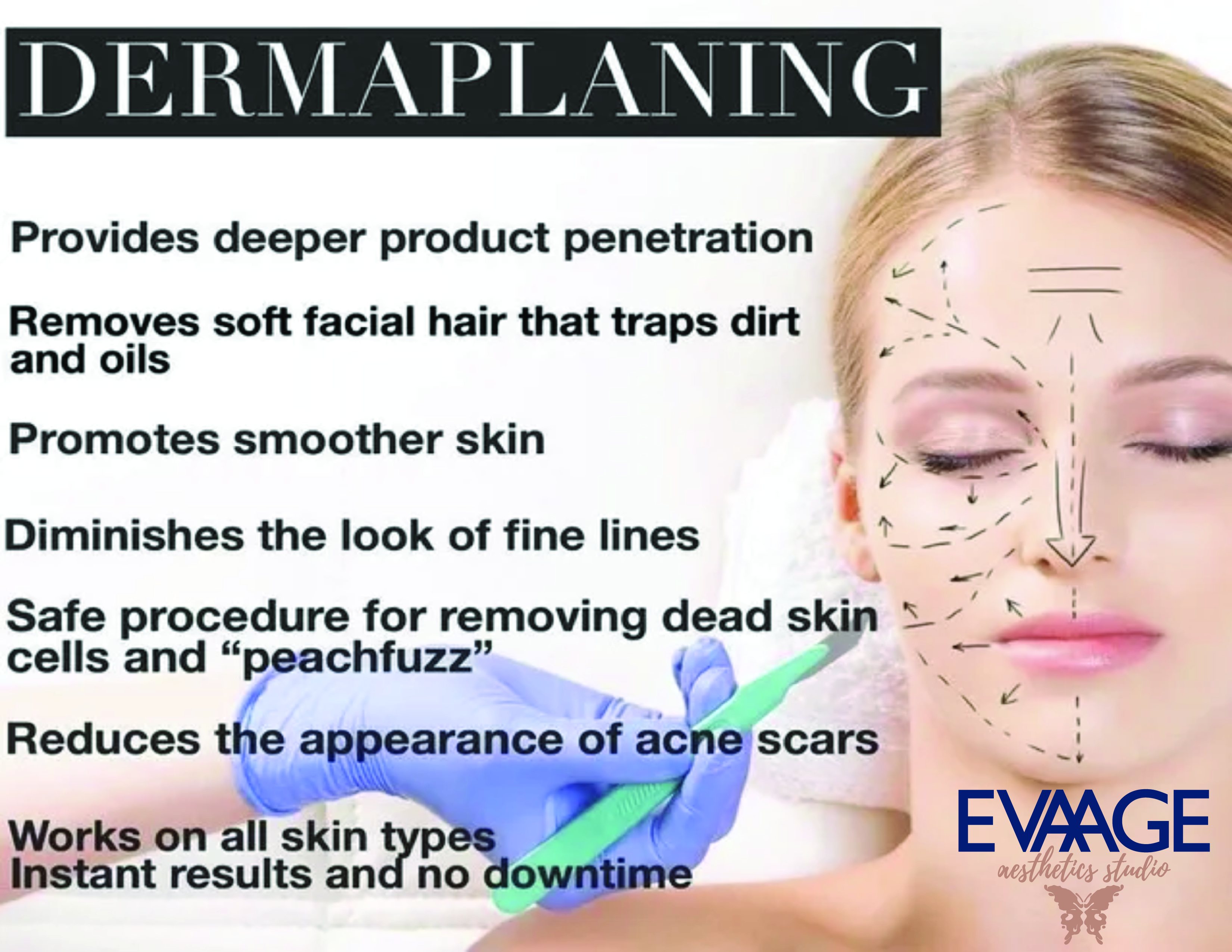
DERMAPLANE
What is Dermaplaning? Dermaplaning is a form of manual exfoliating/skin resurfacing procedure similar in theory to microdermabrasion but without the use of suction or abrasive crystals. A medical grade sterile instrument, called a dermatome, is guided across the skin at an angle to gently remove dead skin cells from the epidermis.
Dermaplaning also temporarily removes the fine vellus hair of the face (aka "peach fuzz"), leaving a very smooth surface. As with any type of exfoliation, the removal of dead skin cells allows home care products to be more effective, reduces the appearance of fine lines, evens skin tone and assists in reducing milia, closed and open comedones, and minor breakouts associated with congested pores.
Dermaplaning can be an effective exfoliation method for clients that have couperose (tiny blood vessels near the surface of the skin), sensitive skin or allergies that prevent the use of microdermabrasion or chemical peels.
What should you expect during your treatment? Your aesthetician will perform a thorough skin analysis prior to your first epiplaning treatment. If dermaplaning is not appropriate, you will be informed during this session and an alternative treatment may be recommended instead. If dermaplaning is approved, maximum results are obtained by participating in a series of treatments plus following a home care regimen. Your aesthetician will review your current daily regimen and skin care products, advise you on which products you should continue to use, and recommend any additional products or changes to your regimen to enhance your desired outcome.
Also, your aesthetician should take every precaution to ensure that your skin is well hydrated and calm following each session. However, you may experience excessive dryness or even some peeling between sessions, always contact your aesthetician if you have any concerns. More sensitive skin may experience some redness after the first couple of sessions. This normally goes away after 2 to 3 hours.
After your treatment, SPF 30+ is highly encouraged be worn at all times. Tanning beds should never be used. You are making an investment in your skin: therefore, it is to your benefit to continue to protect it long after your series of treatments is completed.
Is satisfaction guaranteed? The majority of clients receive noticeable, satisfactory to above average results with a series of treatments and a commitment to a daily skin care regimen. However, this outcome cannot be guaranteed as maximum results are highly dependent on age, cumulative sun exposure, health, lifestyle, genetic traits, general skin condition, and willingness to follow recommended protocols. Be aware that many changes may occur deeper within the skin over time. To continue the maintenance of your skin after you complete your treatment(s), your aesthetician may inform you of long-term age management programs.
What are the benefits of receiving a dermaplaning procedure? There are many ways our skin can benefit from dermaplaning. As with all skin care, regular routine care is essential in maximizing the benefits of any service. Below are some of the highly sought after benefits, when performed every 4 to 6 weeks:
- Provides deeper product penetration
- Removes soft facial hair that traps dirt and oils
- Promotes smoother skin
- Safe procedure for removing dead skin cells and “peachfuzz”
- Reduces the appearance of acne scars
- Diminishes the look of fine lines
- Works on all skin types
- Instant results and no downtime
What are the contraindications? What would prevent someone from receiving a dermaplaning procedure? Although it is impossible to list every potential risk and complication, the following conditions are recognized as contraindications for epiplaning treatment and must be disclosed prior to treatment.
- Active acne
- Active infection of any type, such as herpes simplex or flat warts.
- Any raised lesions
- Any recent chemical peel procedure
- Chemotherapy or radiation
- Eczema or dermatitis
- Family history of hypertrophic scarring or keloid formation
- Hemophilia
- Hormonal therapy that produces thick pigmentation
- Moles
- Oral blood thinner medications
- Pregnancy
- Recent use of topical agents such as glycolic acids, alpha-hydroxy acids and Retin-A
- Rosacea
- Scleroderma
- Skin Cancer
- Sunburn
- Tattoos
- Telangiectasia/erythema may be worsened or brought out by exfoliation
- Thick, dark facial hair
- Uncontrolled diabetes
- Use of Accutane within the last year
- Vascular lesions
What should I expect after the procedure? Aerobic exercise or vigorous physical activity should be avoided until all redness has subsided. Direct sunlight exposure is to be completely avoided immediately following the treatment (including any strong UV light exposure or tanning beds). Although SPF 30+ should already be a part of your daily skin care, after epiplaning, SPF 30+ must be applied daily to the treated area for a minimum of two weeks. Twice daily cleanse the treated area with a post-treatment cleanser, followed by a serum or treatment cream and follow with SPF 30+ sunscreen.
As always, if you have any questions or concerns, please do not hesitate to reach out!
